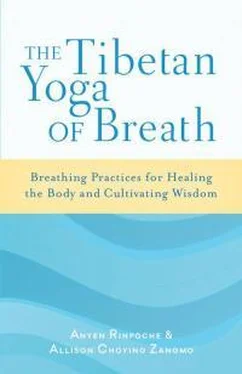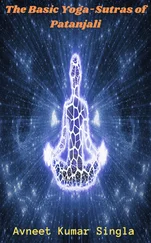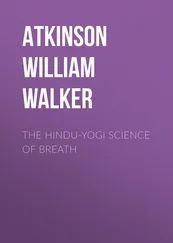Many of us work hard every day to deal with the neuroses that emerge as a result of the impure wind-mind. Dealing with our difficulties and unhappiness in this way, we often look for something (or someone) outside of ourselves to blame for the way we feel. When we search for people and situations to blame, we can easily find many circumstances or people in the past who, we feel, did not meet our needs, or teach us healthy behavior, or treat us in the way that we deserved. But even if these thoughts are true, from the point of view of the Buddhist teachings, analyzing the past will not move us beyond suffering. And although we can get some relief from expressing our emotions, the simple act of expressing emotions cannot fully release us from the bonds of suffering. When we do this, it is as though we are treating the symptoms of a disease rather than the illness itself.
Some schools of modern psychology, such as cognitive therapy, recognize that looking for outer sources of emotions and emotional moods may not be helpful at alleviating mental and emotional imbalance. Rather, cognitive therapy focuses on the thoughts themselves as creating our moods. Similar to instruction given in some general meditation techniques, patients learn to recognize that the way they interpret situations around them is based on pervasive thought patterns. Because the mind often distorts, interprets, and spins events and situations, cognitive therapists teach their patients to recognize that whatever thought arises in the mind is just a thought. And thoughts often do not reflect reality. 1Learning not to grasp thoughts and feelings so hard and letting go of looking for a source—in other words, not searching for something outside of ourselves to blame for our moods and feelings—can alleviate some of our suffering.
However, wind energy training takes the purification of emotions and habitual thought patterns a step farther. Effective wind energy training, as will be taught in part 2, works with what is beneath the expression of strong emotions: the impure wind-mind. It deals with what is arising right now, at this very moment. After all, we can only deal with our mind as it is currently, in the present. When we calm the wind, we calm the mind.
PURITY AND IMPURITY
Both the pure and the impure aspects of our wind energy have been with us right from the beginning. In the Tibetan texts that describe the philosophy of medicine and meditation, the body is described as having not only a physical aspect, our “physical body,” but also an energetic aspect, the “energy body.” Tibetan texts describe the energy body as being a series of channels that are either pure or impure; in other words, they can carry either pure wind energy or impure wind energy. Purity refers to the aspect of wisdom, and impurity refers to neurotic or ordinary dualistic mind.
The sympathetic and parasympathetic nervous systems, the two aspects of the autonomic nervous system according to Western medicine, are the closest comparison we can draw to the Tibetan idea of the channels that run throughout the body. It is not a perfect analogy, because the two medical systems do see some aspects of body and mind differently. However, the nervous system has functions that resemble the concept of the channels. For example, like the channels, the nervous system carries the body’s energy and impulses to the tissues and organs in different parts of the body. And as we have seen, working with the breath can regulate the sympathetic nervous system to reduce agitation and stimulate the parasympathetic nervous system to invite relaxation. The breath brings the energy of our entire system into balance.
From the point of view of Tibetan Buddhist philosophy, the channels carry the wind energy throughout the body to all of the tissues and organs, including the brain. We tend to live in our neurotic mind, which, as explained above, always has at least some trace of impurity, agitation, and imbalance. Because we tend to be habituated to the impure aspect of wind-mind, however, it can dominate both our mind-set and the body’s energy.
Pure wind energy naturally resides within the body and some of the energy channels. However, pure wind energy is overpowered and weak because the impure wind energy is the primary traveler through our channels. Although pure wind energy is present within the body and mind, it cannot express itself. We cannot see or feel it. So our experience is dominated by the aspect of impure wind-mind. As we have already seen, this impure wind energy is not only the basis for improper behavioral breathing; it is also perpetuated by improper breathing. The relationship between unhealthy breathing and the impure wind-mind is also self-perpetuating; it takes on a life of its own.
Tibetan Buddhist philosophy also illustrates a strong relationship between how extreme states of mind manifest and how the impure wind moves through the energy channels. When the channels themselves are impure, they are knotted or twisted rather than running straight through the body, causing extreme types of imbalances. The Tantras state that when wind energy gets caught in the twists and turns of the channels, our energy is varied, erratic, and unpredictable in the same way that a turbulent river runs through extreme twists and turns. However, when a yogi eradicates the very last traces of neurotic mind and realizes the nature of wisdom, the channels are unknotted, untwisted, and unblocked.
KARMA AND WIND ENERGY
Another way that the Tibetan Buddhist teachings describe impure wind energy is with the phrase karmic wind, or le lung (Tib. las rlung). The teachings tell us that in order to tame our neurotic mind, we must dispel the karmic wind from the lungs, where it generally dwells. This enables us to experience a softer, more natural type of breath called wisdom-wind, which naturally abides in the heart. These two names point out two aspects of the wind energy: that which is “karmic” is impure, or related to the aspect of ordinary, conceptual mind; and that which is “wisdom” is pure, or related to the aspect of wisdom that is hidden, but dwelling inside of us.
But what does it really mean to describe the wind energy as karmic wind ? First, let’s think of what our ordinary understanding of karma is. Most people have a sense that what they do will come back to them—the Golden Rule. When we do good for others, we have a feeling that others will also care for us. And likewise, when we harm others or create chaos in our relationships, we feel that, one way or another, our actions will come back to haunt us.
Another way we understand karma is similar to fate. In our ordinary language, we can use the word karma to describe something happening outside of us, or happening to us, that we feel we have no control over. When an unpleasant situation arises, we shrug our shoulders and say, “That’s my karma,” meaning, “There’s nothing I can do about it.” But this view of karma is limited; for someone practicing wind energy training, neither of these is a proper understanding of how karma interacts with the body, the mind, and the breath.
Every situation that manifests in our lives arises from causes and conditions coming together at that moment in time. These causes and conditions represent the confluence of a multiplicity of circumstances—people, places, energy, and events. We could also say that the experiences we are having right now are the interaction of the karma we have already accumulated in the past and the karma we are accumulating in the present.
Three Types of Karma
Generally speaking, it can be helpful to think about karma in three different ways. From the point of view of the Buddhist teachings, some karma was accumulated countless lifetimes ago and is just now ripening in this life’s body, speech, and mind. Other karma was accumulated in this particular lifetime and will ripen in this or a future lifetime. But we are also accumulating karma in this very moment. This presently accumulating karma is based on our perceptions, responses, and beliefs about all of the experiences that are currently appearing before us and happening to us.
Читать дальше












